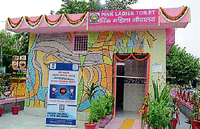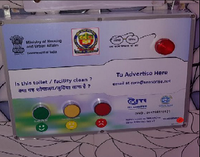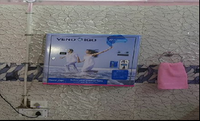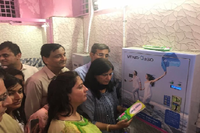The Pink Toilets
Introduction
According to the United Nations Children’s Emergency Fund. (UNICEF),  around 595m people defecate in the open in India, which is more than half the population of the country, leading to health and environment hazards.
around 595m people defecate in the open in India, which is more than half the population of the country, leading to health and environment hazards.
Women from all economic strata’s are affected by unavailability of public toilets but the problems of those women from the lower economic strata are aggravated since they hardly have any options. The issue of toilets is more serious in urban areas rather than rural areas, because in rural areas, there are open spaces and fields, whereas in urban areas, spaces are cramped and open space is deficient. There are issues of communicable diseases as we know that women are far more vulnerable to urinary tract and reproductive tract infections than men, sexual harassment (women in slum areas, typically tend to relieve themselves at late hours of the night or early hours of the morning - which makes them vulnerable to rape, molestation).
Inadequate menstrual protection makes adolescent girls (age group 12-18 years) miss 5 days of a school in a month (50 days a year). Around 23% of these girls actually drop out of school after they start menstruating. Building an agenda for adolescent health requires that the multi dimensional health needs and special concerns of adolescents are understood and addressed in National Policies and a range of programme at different level. The implementation of this vision requires support from the government and other institutions, including the health, education as well as adolescents own families and communities.
years) miss 5 days of a school in a month (50 days a year). Around 23% of these girls actually drop out of school after they start menstruating. Building an agenda for adolescent health requires that the multi dimensional health needs and special concerns of adolescents are understood and addressed in National Policies and a range of programme at different level. The implementation of this vision requires support from the government and other institutions, including the health, education as well as adolescents own families and communities.
Toilets built specifically for women and children, can address health and hygiene concerns. A smart toilet compound exclusive for women and children which also provides basic checkup facilities, sanitary napkins vending machine and incinerators, breastfeeding area, as well as safe drinking water to women and children, will be an extraordinary initiative and a model to reckon with.
Keeping in view, National Commission for Protection of Child Rights (NCPCR) took initiative of such facilities for women, especially adolescent girls in Delhi. Couple of meetings were held at NCPCR with all the concerned stakeholders to formulate the same for improving hygiene and health conditions of adolescent girls. An innovative concept called Pink Toilets was developed by NCPCR. 'PINK TOILETS"- toilets pink in colour so they are easily identifiable, protects privacy, provides sanitary napkin vending machine, incinerators to burn them and prevent pollution, disable friendly etc.
First Pink Toilet in Delhi
South Delhi Municipal Cooperation (SDMC), agreed to initiate the concept of Pink Toilets at Vikaspuri, Delhi.
On International Day for the Girl Child, NCPCR and South Delhi Municipal Corporation inaugurated the first Pink Toilet in the capital city's Vikaspuri area on 12th October, 2017. This one-of-its-kind facility is a significant step towards creation of a hygienic public restroom for women and children. To ensure safe menstrual hugeine, the Pink Toilet is equipped with a sanitary napkin vending machine and incinerator facility. Moves like this give a boost to the ambitious Swachh Bharat Mission.
Corporation inaugurated the first Pink Toilet in the capital city's Vikaspuri area on 12th October, 2017. This one-of-its-kind facility is a significant step towards creation of a hygienic public restroom for women and children. To ensure safe menstrual hugeine, the Pink Toilet is equipped with a sanitary napkin vending machine and incinerator facility. Moves like this give a boost to the ambitious Swachh Bharat Mission.
The South Delhi Municipal Corporation chose the  market in Vikaspuri for construction of the Pink toilet as it sees a high footfall of women and girls and they always face a lot of problems in accessing hygienic toilets and toilets with sanitary napkins and facilities for their safe disposal.
market in Vikaspuri for construction of the Pink toilet as it sees a high footfall of women and girls and they always face a lot of problems in accessing hygienic toilets and toilets with sanitary napkins and facilities for their safe disposal.
Features and Facilities at the Pink Toilet
- Separate toilet facility only for women, adolescent girls, children
- Pink coloured for easy identification by women
- Clean washrooms with both Indian and Western toilet facilities
- Low height toilets and basins for children
- Basin with running water and hand-washing facility
- Easy signage
- Bright and vibrant with proper lighting
- Availability of lady caretaker 24/7
- Sanitary napkin Vending Machines and Incinerators for women (napkins available for marginal cost)
- Instruction for care of toilet and usage of napkins to be put up in board
- Helpline numbers to be placed in boards
- Disable friendly; availability of ramps
- Private area for child care inside toilet campus
- Seating area outside the pink toilet
- Feedback mechanism to share inputs about experience of usage
- Availability of toilet location in the app
Source : NCPCR
Last Modified : 2/21/2020
This topic provides information about Sim Card Swa...
The Article provides information about Antioxidant...
This topic provides information about 20th Livesto...
This topic deals with information related to Appen...
